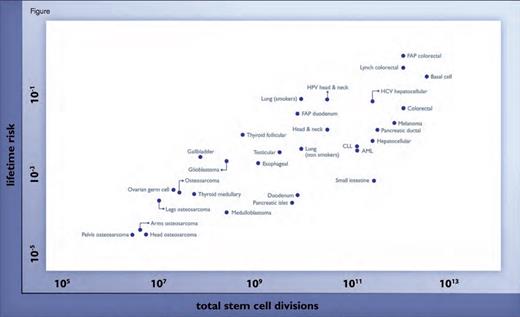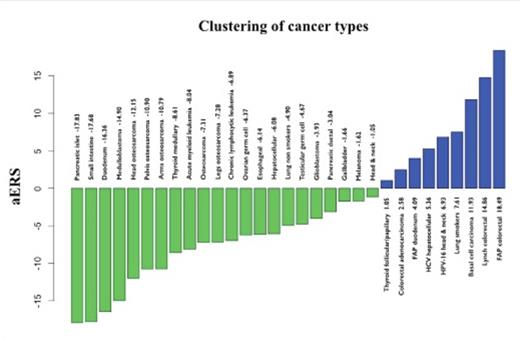Stochastic (Replicative) Factors Versus Environmental and Inherited Factors: R-tumor Versus D-tumor Classification. The adjusted ERS (aERS) is indicated next to the name of each cancer type. R-tumors (green) have negative aERS and appear to be mainly due to stochastic effects associated with DNA replication of the tissues’ stem cells, whereas D-tumors (blue) have positive aERS. Importantly, although the aERS was calculated without any knowledge of the influence of environmental or inherited factors, tumors with high aERS proved to be precisely those known to be associated with these factors. From Tomasetti C, Vogelstein B. Cancer etiology: Variation in cancer risk among tissues can be explained by the number of stem cell divisions. Science. 2015;347:78-81.Abbreviations: FAP = Familial Adenomatous Polyposis; HCV = Hepatitis C virus; HPV = Human papillomavirus; CLL = Chronic lymphocytic leukemia; AML = Acute myeloid leukemiaReprinted with permission from AAAS.
Stochastic (Replicative) Factors Versus Environmental and Inherited Factors: R-tumor Versus D-tumor Classification. The adjusted ERS (aERS) is indicated next to the name of each cancer type. R-tumors (green) have negative aERS and appear to be mainly due to stochastic effects associated with DNA replication of the tissues’ stem cells, whereas D-tumors (blue) have positive aERS. Importantly, although the aERS was calculated without any knowledge of the influence of environmental or inherited factors, tumors with high aERS proved to be precisely those known to be associated with these factors. From Tomasetti C, Vogelstein B. Cancer etiology: Variation in cancer risk among tissues can be explained by the number of stem cell divisions. Science. 2015;347:78-81.Abbreviations: FAP = Familial Adenomatous Polyposis; HCV = Hepatitis C virus; HPV = Human papillomavirus; CLL = Chronic lymphocytic leukemia; AML = Acute myeloid leukemiaReprinted with permission from AAAS.
While it is commonly understood that the environment and heredity contribute to the development of cancer, what if something else contributed to carcinogenesis? Johns Hopkins University School of Medicine researchers Dr. Cristian Tomasetti, from the Division of Biostatistics and Bioinformatics in the department of Oncology, and Dr. Bert Vogelstein, the Clayton Professor of Oncology, Howard Hughes investigator, and co-director of the Ludwig Center for Cancer Genetics and Therapeutics, postulated that the stochastic effects associated with the cumulative number of divisions within stem cells of each organ contribute to the lifetime risk of cancer arising in that organ. From the literature they identified 31 tissue types from which the number of stem cells had been quantified. They then plotted the total stem cell divisions for each tissue during the average lifetime of a human (x axis) versus the lifetime risk for cancer of that same type using Surveillance, Epidemiology, and End Results (SEER) data on the y-axis (Figure 1). The results show a significant positive correlation (Spearman’s rho = 0.81; p < 3.5 × 10-8). This finding suggests that 65 percent of the variation in cancer risk among different tissue types is attributable to the total number of stem cell divisions. They postulate that the stochastic effects of DNA replication, not environmental or inherited factors, are the major contributor to human carcinogenesis.
Whether you call the stochastic process of stem cell divisions “random chance” or “bad luck” is controversial, but highly quotable. Multiple news publications misinterpreted the data from this article, stating incorrectly that two-thirds of cancers are due to random mutations. In fact, as the authors state, roughly two-thirds of the difference in the risk of cancer between different cancers is due to the number of tissue-specific stem cell divisions. This stochastic process of DNA replication in stem cells and its relationship to cancer implies that errors during DNA replication (somatic mutations) affect the risk for carcinogenesis.
Clustering of Cancer Types. The Relationship Between the Number of Stem Cell Divisions in the Lifetime of a Given Tissue and the Lifetime Risk of Cancer in that Tissue. From Tomasetti C, Vogelstein B. Cancer etiology: Variation in cancer risk among tissues can be explained by the number of stem cell divisions. Science. 2015;347:78-81. Reprinted with permission from AAAS.
Clustering of Cancer Types. The Relationship Between the Number of Stem Cell Divisions in the Lifetime of a Given Tissue and the Lifetime Risk of Cancer in that Tissue. From Tomasetti C, Vogelstein B. Cancer etiology: Variation in cancer risk among tissues can be explained by the number of stem cell divisions. Science. 2015;347:78-81. Reprinted with permission from AAAS.
Drs. Tomasetti and Vogelstein clustered different cancers into two types using an “extra risk score” (ERS), which was defined as the product of the total number of stem cell divisions and the lifetime risk for each cancer type (Figure 2). Tissue types with a high ERS were those with a high cancer risk relative to the number of stem-cell divisions. They found that high-ERS tumors were known to have hereditary risk factors or environmental links and designated such tumors as “deterministic [D-tumors]” given the strong effect that such factors had on the risk of tumor development. In contrast, low-ERS tumors were termed “replicative [R-tumors]” as their risk was mostly strongly affected by the stochastic process of stem-cell divisions with minimal known contributions by hereditary predisposition or environmental mutagens. The authors stressed that even for D-tumors such as familial adenomatous polyposis (FAP) related to inherited mutations in the APC tumor suppressor gene, “replicative effects are essential.” They noted that the rate of FAP colon cancers are 30-fold greater than that of FAP cancers of the duodenum, which they link to the 150-fold increased number of stem cell divisions in colonic versus duodenal tissue. The authors also cited the example of melanoma and basal cell carcinoma, which share the same carcinogenic exposure [and dose] of ultraviolet light. They proposed that the much greater frequency of basal cell cancers vs. melanoma relates to the higher number of divisions within skin epidermal basal cells compared with melanocytes.
In Brief
The public health implications of such findings are controversial and attention grabbing. For example, does primary prevention even matter for replicative tumors? These data will certainly prompt a rethinking of the role for primary versus secondary prevention strategies based on D- versus R-tumor types and how resources should be optimally allocated to manage cancer risk. While these implications are debated, this new model of carcinogenesis is reshaping how we view the relative contributions of nature, nurture, and random chance.
Competing Interests
Dr. George indicated no relevant conflicts of interest.


